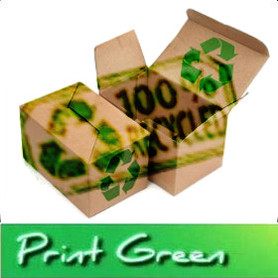 How can we actually say that a product is indeed Eco-friendly? Products claiming they're hundred percent made from recycled organics and materials, yet they look bulky with those plastic wrappers and packaging. Are they really Eco-friendly? Maybe if we look at it this way, such that the product was actually a recycled matter and soon it will decompose once reaching their limit. But what are going to do with those plastic wrappers and packages, unless they're also decomposable or organic, they'll soon bring harm to the environment if not properly dispose. Styrofoam and plastic packaging are not environment-friendly, thus if you try to purchase a product with a mark that says '100% made from recycled materials', yet it was packed in bubble wraps or Styrofoam, that's a bit absurd. They're promoting green products, but they still incorporate non-degradable materials into the packaging. Thus it makes sense, that recycled consumables with less packaging are more Eco-friendly. Paper supplies that are used for printing, recycled or not, are necessities in most offices. If you would prefer to purchase recycled paper sheets, then it is much better not only for your office environment but also for the environment. What makes it a good choice for your office? First they are cost-efficient, thus saving you some good bucks and cutting down your office supplies cost, and second, you promote green printing practices not only to yourself but extending the benefits of it to all your employees. Shopping for your weekly or monthly groceries, whatever you prefer, is one of the factors why you get tons of plastic bags in your house, and mind you, not all recycling plants and organizations accept every kind of plastic waste. Thus, it leaves you with no other choice but to discard all those waste, which then goes to the landfills. So what makes you a green and better shopper? Bring your own reusable bags, a big one so you jammed everything you need to buy from the store. Avoid purchasing consumables and products in plastic wrappers, unless you're fond of collecting waste. What's good about products with less packaging is the fact that you don't have to read any tiny-font descriptions of what is it, just look at it. Printer's, everyone own a printer buddy at home, offices or business environments, it became a necessity equipment actually. Inks and toners, let's set them aside, as there's still no solid solution that can replace those chemicals to create greener printouts. But, printer cartridges can be recycled, even the major brands and big names in the print industry accept returned cartridges to undergo recycling process. Although the packaging is still the same, there are some manufacturers working on providing a better packaging or at least less packaging if they will allow. These eco-friendly toner cartridges and ink cartridges are made from empty and used printer consumables, refurbished and recycled to re-use. Manufacturers can do a lot of things and a way better solution to their products packaging. It's just that they use it for promotional purposes, imprinting brand names, logo and stuffs like that into the box and wrappers. What could be the use of a green eco-friendly product, if it's inside a harmful packaging, it's like eating junk food to suffice your hunger but you don't get nutritional value.
Soy ink as it became more popular in the printing industry, has also brought a few misconceptions and notions, one of which is the false idea of thinking that this type of ink is actually made of pure soy components. Now to shed some light on this matter, let's deal with some of the facts and mistakes that come along with soy inks. First, are soy inks really made of pure soy products? If somebody says yes, that is a mere misconception, literally ink products composed of oil, pigments, resins and other various components that makes an ink material. Certainly it's a soy based ink, but not purely made of soy. Carcinogens are also required to produce ink products, a mineral pigment used for black color inks. Aside from the fact that inks commonly comprise of renewable materials, there are also a few components required in the process of making this material that can't be renewed easily, one good example of which is petroleum. Although there were ink products emerging in the market that claimed to be made of organic materials, petroleum in ample amounts are still considerably added to ink compounds. When comparing the actual volatile organic compound emissions of conventional ink products over soy-based inks, there's still an argument with regards to this matter. Soy is considered a vegetable, and oils that come from vegetable products when cross link tend to dry out, during the process it emits volatile organic compounds. But given those ideas, conventional inks used in many printer nowadays can still emit and produce more volatile organic compounds. Printouts made from soy-base inks aid better paper recycling, a line that anyone of us might have read from most articles talking about soy ink products. There's an accurate study conducted with regards to this assumption, a laboratory study from Midwestern University proved that soy-based ink can be easily remove from paper pulp during the recycling process. However, during the study they only used a 4 week old printed material, while based from another study, it reveals that soy inks when aged onto the paper pulp, it penetrates stronger which makes it harder to be removed. Soy-based inks are biodegradable, but are they really the most convenient option when it comes to environment-friendly printing? Sustainability wise, the answer would probably be yes. But it is just the ink that was re-invented, how about the cartridge which is more concerning. As we all know, printer cartridges are made of plastic components, and to be able to manufacture plastic, non-renewable and minerals are used and consumed. I think instead of debating about the real deal between soy inks versus conventional inks, it would be better if we put more attention on the recycling process of the material from where the ink houses. If you're asking what could be the most possible environmentally-efficient printer consumable, how about we combine vegetable-based inks with recycled printer cartridges, that would be far more greener. Recycled eco-friendly toner cartridges, ink cartridges and other remanufactured printer supplies are all beneficial for the environment.
Have you seen a printer that instead of making printouts, toasted breads are ejecting from it? It's not very common for us to see new and peculiar equipments, sometimes there are few concepts that are just too good to be true. Even a bread toaster isn't something too exciting to see, but knowing that it features a naive design and an unusual concept, then that makes you curious. An unusual application of printer concept has been applied to one of our easy breakfast meal helper, a bread toaster that mimics an inkjet printer. Designed by Othmar Muhlebach and was named Printer Toaster, with the goal to renovate a somehow usual tool into something that kicks a new way of creating a hot and fresh toasted bread. Consider it as the modernize way of toasting wherein you just have to wait for the bread to drop on the lower tray, nicely done, hot and ready. The design won second prize at the Berner Design Awards. If you're familiar on how an inkjet printer or a fax machine shoots a paper sheet, then watching the Printer Toaster will surely amaze you the same way. Now if you still can't get enough, how about while waiting for some of the breads to get toasted from the Printer Toaster, make some or rather burn some nice images onto your bread. How is it possible? Meet the Zuse Toaster, it can burn an image with at least 12 x 12 pixel in size. The said printer can be re-programmed so users can create a random image printout in a loaf of bread. Literally put a smile on every bread you serve and have a fun breakfast with your family and friends. What I'm partly hoping is that, it would be better if this Printer Toaster can be equipped with real cartridges wherein instead of inks, users can put jams of different flavors as well as butter. Also, why not transformed a laser type printer to something like the Printer Toaster, it can probably toast your bread and create an image all at the same time. While we can't afford to buy either of the two unique printer, don't even try disassembling your personal printers just to have one. Instead practice green printing to cut down your printer expense and help save the environment as well, by using eco-friendly toner cartridges and ink cartridges on your printers.
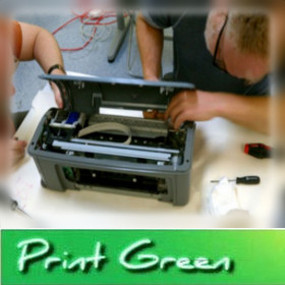 Photo Credit : Instructables BioPrinter Bioprinting as an emerging technology, has gone through a lot of innovations and development that lead to its specific goal of achieving to develop new human tissues and organs. Through hard works and research done on bioprinters, full organs were produced and used by many which create a huge shift on their life. If we will define it, Bioprinting or tissue engineering, is the process the produces organs via a printer that feeds biological materials. An inkjet printer is used as the machine, but instead of ink, cells are deposited on a surface layer by layer, thus an organ has been produced. 3D printer nowadays are being modified to produce the same output, however the success isn't that much. Leaning to his own ingenuity, Patrik, one of the genius member of Instructables, modified an HP inkjet printer, and to his success he was able to transform that abandoned machine into a working DIY Bioprinter. For the complete information about Patrik's DIY Bioprinter, you may refer on the link here. Hacking an old inkjet printer isn't something new to hear, but the fact that it was transformed into a bioprinter is an amazing reason to give credits to this man. Patrik and his team work with the inkjet printer by undressing it first, disassembling the components and covers, as well as reconstructing a new wire system for the paper handling mechanism. After checking if all the buttons are still working fine after all the alterations and modifications inside the printer, next thing they do is prepare the cartridges for a dissecting project. Since it's the printer uses inkjet technology, therefore the project requires inkjet cartridges, unless someone might take the challenge modifying a laser type printer, so there would be a bigger container such as a toner cartridge that can be filled with more biological materials. For printer users who practice green printing, consider opting for eco-friendly toner cartridges and ink cartridges for all your printing needs. They open the cartridges that will be used and tried to fill it with biological materials. Making sure that even though they'll be using new cartridges, they make sure that it's been free from clog and residues, neither no holes, by rinsing each cartridges with distilled or deionized water. Then running a few test print to see if the cartridges and the printer synchronously work together. With their first test print, the team printed arabinose over a half filter paper - placed on an agarose plate that lights up under UV light. To their success, they were able to print a BioCurious eyeball logo. Perhaps their project still needs some refining process to make it work as a fully functional BioPrinter.
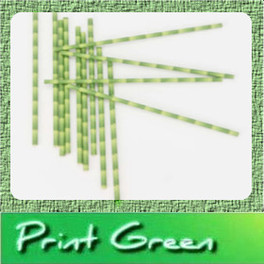 Straw materials are typically made out of plastic components, one good example would be drinking straws, which we often use to sip and enjoy the beverages we drink everyday. Though we don't get to use drinking straws everyday, like with coffee, you don't have to use a straw to drink it unless it's an ice coffee, nonetheless you can use a straw. There are other straw products aside from the one we use to sip a cold beverage. But instead of enumerating those, more than anything else, we should be talking about the material these products were made. Plastic, such a material used to produce different products, yet it tends to leave negative impacts on the environment. Although there were innovations that changed the industry by developing alternative materials from which we can substitute to plastic use. Through those inventions, the use of plastic materials have been reduced over the past years. Substituted by environment friendly, degradable materials that can be utilize as an alternative consumable in place of plastic. As an addition to those plastic alternative materials, here's the Birch and Bamboo Paper Straws that let you experience the way you get used to drink your beverages while being eco-friendly at the same time. It has been described as, "Eco-friendly straws that are made of paper, and have been wax-coated. The unique birch and, bamboo wood patterns have been created using a soy-based ink. These paper straws are a fantastic green alternative to the mainstream plastic variety that are often harmful to the environment."Helping the environment while having fun drinking with a unique straw, what a great way to enjoy your beverages. And to have a more greener life style, try using recycled products and consumables as your alternative daily supplies. Include on your list these eco-friendly toner cartridges and ink cartridges as your printer consumables for a greener and better way of printing.
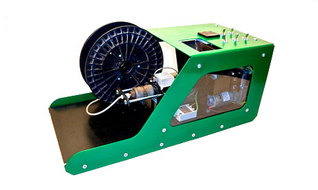 Photo Credit : Kickstarter It's been several months since 3D printing technology became available to the masses, more affordable, convenient, compact and improved versions have been developed for the consumers to utilize. The way consumer goods were fabricated was transform and became more customizable, enhanced and of course easy, but still the products sturdiness and quality remain. Although we can purchase a machine that can produce three-dimensional products and stuffs for us to either use personally or for whatever purpose we wanted, it's just a one time expense we're talking about here. Let's not forget the point that as 3D printer user, you should also consider the cost of maintaining the machine as well the supplies it requires to run. And that particular 3D printer consumable is the plastic filament, which is typically costly and yes a bit of hard to find. For those who are not aware of how much would it cost to buy a plastic filament for 3D printers, well it will cost about $50 or more to purchase a single spool of it. Fortunately, for those who find it a troublesome to replace their printer's filament, here is a great solution that will put an end to your problem. The Filabot, " a machine that allows anyone to make their own 3D printing substrate from old recyclables sitting in the bin." Invented by Tyler McNaney, a genius student from Vermont Technical College in Randolph, United States. Tyler's invention which was funded by Kickstarter, is a compact machine that can turn waste plastic material into a usable filament for 3D printing. Filabot, with its 12 x 12 x 24 dimension, can powerfully grind and melt, then eject the material out of its small recycling-plant-like housing. From an actual test, a single milk container and a detergent bottle can actually be enough to produce an 8 feet long plastic filament for your 3D printer. There's a coil heating element inside this terribly small machine, it varies the temperature to accommodate different types of plastic material. It's been said that the final model of Filabot will feature a tip that can be adjusted to the desired filament diameter. Now if you're wondering if it's out in the market, then McNaney is currently working on it, to produce a batch of Filabot machines to sustain the first wave of orders. For Kickstarter backers, you can get this machine for about $350. When will it be launch to the public, that's a question they can only answer so better check their website for updates. If you've got a lot of plastic waste in your business, then this machine is a business opportunity for you. Make those stream of plastic waste material turn into 3D printer filaments and sell it to the market, that sounds real money. You get a business, plus helping reduce environmental impacts, that's just too awesome. Recycled materials are less cheaper but still sturdy, just like those eco-friendly toner cartridges and ink cartridges, alternatively reliable for your printing needs.
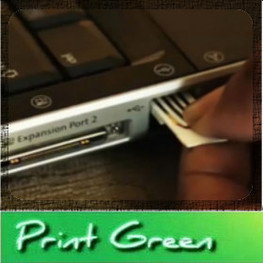 Technology, aside from the fact that it comes with some environmental impacts, it also brought some innovations that led to a few advantages. One of which is the traditional way of using paper materials to keep a copy of files or documents, we then changed it and adapt to the industry advancement through utilizing mobile devices like smartphones and tablets to store our files and documents. Thus, we reduce the amount of paper used to store information and files. Though having said that, it doesn't mean we completely eliminate the use and purpose of paper materials in the digital world. In fact, intelliPaper, a business company that provides products in the data sharing consumer industry, has found a brilliant and extremely surprising way of transforming a tiny piece of paper into a fully functional storage device, specifically the one we called USB drives. One main reason they came up with this invention is cut down the huge waves of e-waste which as we all know, heading to the landfills and contaminates the surrounding environment. If you're wondering how this clever piece of USB technology was developed then here's how, intelliPaper embedded a silicon chip between the layers of paper, laminate those layers, then printed conductive USB traces onto the paper which connect to the main chip. Surprisingly and merely unbelievable, the finished paper USB drive can be embedded into any type of paper product. Although there are micro USB drives like the ones from Verbatim, Buffalo, SanDisk and many more, one thing you should know is that, they're are typically coated of plastic. When the product reached the end of its useful life, just pull out the electronic strip inside and then you can just tossed the paper material right into the bin. Using this device, one thing is for sure, you maximize the usefulness of the paper material you utilize from using it. We've been trying to come up with more ways to reduce our paper usage, and this invention will definitely top the list. You can also practice paper less printing to save on your regular printing expense, or try using eco-friendly toner cartridges and ink cartridges for your printer to save more.
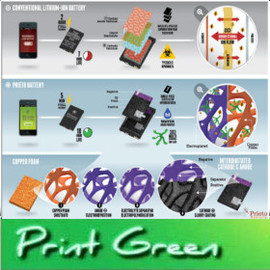 Batteries are intended to supply a small amount of energy for handy devices like our mobile phones. Though it may seem so small to consider doing a research to enhance this teensy device, it's an essential component that almost all devices require in order to operate. Amy Prieto, a Chemistry professor at Colorado State University, have seen the vital importance of a small battery and so she started the Prieto Battery Company that created a three-dimensional battery that is built with a core of copper foam. As it may seems, the project is still in the beginning stages of development. Prieto's hard works on developing this particular 3D foam battery technology could lead to the emergence of high-capacity batteries than can contain energy two times the usual amount it can hold, plus reducing the time needed to fully charge it in as fast as five minutes. There are considerably advance rechargeable batteries in the market that can power the latest smartphones and mobile devices. But they are way too expensive that adds up on the overall cost of the mobile unit, and they actually lose charge in a very short time that users need to recharge the device for about 2-3hours more likely. But there's something we should be worrying more, and that is the fact that these batteries even though they're small in size can also harm the environment with the planet-killing toxins they contain. Amy Prieto have thought, " It’s inexcusable that while our devices have become more sophisticated, our batteries have remained virtually the same for over one hundred years."”It’s just like a sponge, you could think about,” Prieto told Marketplace.org. “Then we paint all the inside spaces with the different materials that you need for the battery. So the ions can go in many different directions, but they don’t have to go very far. So, that’s what I mean by a three-dimensional battery.”They integrated nanowire or copper foam substrate, but both can handle higher power and energy densities than any conventional lithium-ion battery in the market. What's more highly noted from this technology is that these batteries are manufactured using non-toxic chemicals. The said technology has also increase the traditional 500 cycles into an incredible number of 5000 cycles, which extends the life of a battery before it gets wasted and disposed. It is truly an innovation that will change the way we use batteries and also all the devices that needs it. In addition to its promising progress, we should be grateful that here comes another new technology yet never became a threat to the environment. It seems that we're more likely close to reducing e-waste materials in different industries. Noted that now, there are recycled materials like eco-friendly toner cartridges and printer consumables in the market which also reduce carbon footprint. And it's really good to hear about inventions and developments that reduces environment impact.
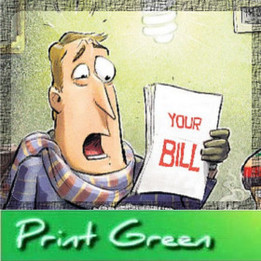 In order to cut down our electricity bills, we often push ourselves to reduce the machines and appliances we use daily, and if we can't avoid to use them, we tend to reduce the amount of time the machine was used, which in a way helps us to save energy. Everyday we been accustomed to a habit that can supposedly be changed in order to save on our bills. One way we can do is to monitor how much electricity a room consumed for a day, this can help us determine which can be deducted or limit in that particular area of the house. Regulate the energy consumption of particular household appliances that are used daily. Light bulbs, either they're turn on all throughout the day or just being lit up at night, these bulbs can be replaced by LED lights. These green picks are energy-efficient which makes them less expensive to use in the long run and works for a much longer life span. If you're familiar with a power strip, a block of electrical sockets that allow multiple electrical devices to get power from a single outlet. Why are these power strips important, simply because each includes a circuit breaker that limits the electrical current flowing through it. By centralizing the power source of some of your appliances, you can shut these machines off easily. Another ideal way is by getting an Energy Audit for your house. This can help you detect the leaks in every corner and spot of the house that causes your electricity bill consumption to rise more than what you expected. According to David Johnston, an energy expert, "air leaks account for 25-30% of an average energy bill". It would be better to pinpoint the areas from which air leaks. Why do you have to this? Air leaks causes your appliances particularly air conditioning unit, heater and thermostat to work harder in order to regulate the proper heat and cold air throughout the house. Switch to household appliances that consumes less power or called as energy-efficient machines. This will literally drawdown your current electricity bill. If you can't afford to replace all the bulbs then it would be better to invest on renovating your windows. Natural light that comes from the sun is way better than fluorescent lights, plus the air outside may be better for your system. Just make it sure that your new windows is built with insulation to prevent any discomfort during different seasons. Of course, aside from cutting down your electricity bill will not generate that much savings, so try to think of ways on how to cut down your other house bills. Don't forget to use environment friendly products and consumables with minimal negative impacts on the environment like eco-friendly toner cartridges and ink cartridges for your printing needs. Avoid using plastic materials as much as possible and reduce your own waste. Control your daily habits and think of ways on how you can reduce your carbon footprints.
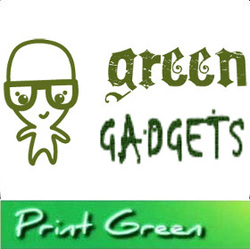 Since we are focusing on reducing our environmental impact this year, maybe we should start using materials and equipments that are more environment friendly, power-efficient and less expensive. In addition to our goals and resolutions to live a greener life by eating healthier foods, lose some weight, be more conscious for the environment, save more by using recycled material and so on, we should also focus on reducing the negative impacts that we may bring to the environment. Now in order to make this goal move and progress, we should learn what materials and commodities we should be using to reduce our daily environmental impacts. Well of course if you can't afford to purchase or convert your household equipments into these greener machines, it would be better to start with doing the basics like recycling and upcycling. By doing these two things you can reduce your accumulated waste, you utilize materials and supplies that are still reusable, plus you save a lot by refraining yourself from buying new supplies. There are things to consider when buying supplies and all other stuffs is the products energy consumption, materials it composed, its environmental impact, and last would be the price. Cut down your energy consumption, that would greatly save you some money that you can spend on more important things. Consider checking the materials from which the product was made of, as well as the impact it could bring to the environment. Products with less carbon footprint especially recycled consumables are way cheaper and sturdy compared to branded ones. Here's a list of some good choice equipments that will help you with your goal to have a greener year. First on our list is the Solar Charger Kit. Houses nowadays can be powered by a photovoltaic system, but the option to completely sustain your house with solar energy can be a bit expensive. So instead, you can use solar powered charger kit that features a V60 battery capable of supplying enough energy for your laptops, tablets, mobile devices, digital cameras and handheld devices. It's even lightweight that you can bring it wherever you wanted and use it just when you need it. Next would be the Programmable Thermostat. We often spend much of our hard-earned money from paying our electricity bills. And it's a fact that half of our bill comes from the household equipments we used for cooling and heating. That's the reason why it's a necessity to install a Programmable Thermostat. Through this device, you can monitor your house's temperature remotely with the use of your smartphones or iOS devices. It's more easy, more convenient and much effective. Last and one of my favorite is the HoneyComb Shade from Lutron. These wonderful DIY shades "are made of fabric that have air pockets that trap heat during the winter and shut out solar radiation in the summer, providing for superior insulation while still allowing natural light to permeate." And what I love the most with this product is that it comes with a remote controller, deducting the wires and strings that can be found on conventional blinds from which kids love to tug and tangle. You can also opt for recycled or re-manufactured products and consumables that are cost-efficient and are good for the environment. For example, your printer consumables particularly the cartridges can be replace with eco-friendly toner cartridges and ink cartridges, they're way cheaper and provides the same quality of par with the original products. There are lots of recycled products in the market that will definitely suit your style and daily routine, you just have to find what's best for you.
|








 RSS Feed
RSS Feed